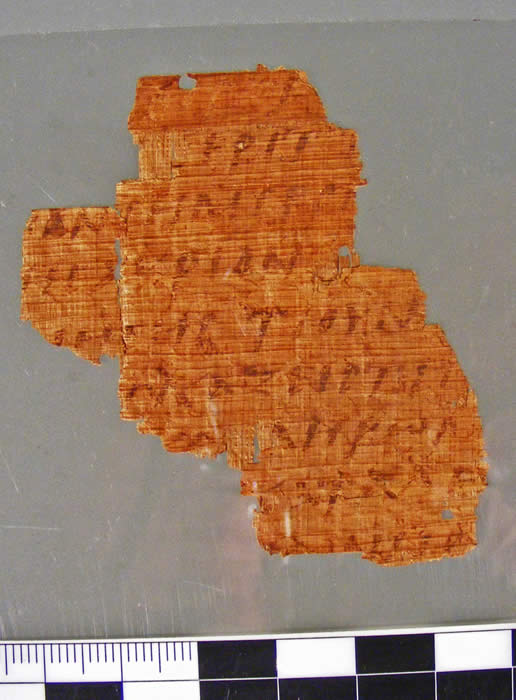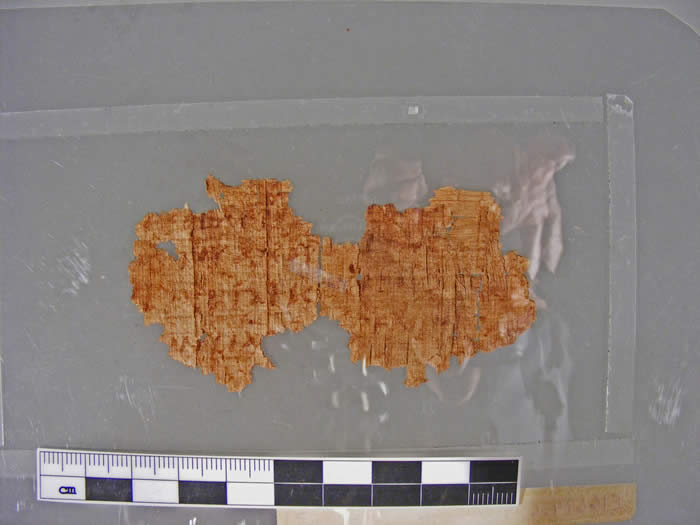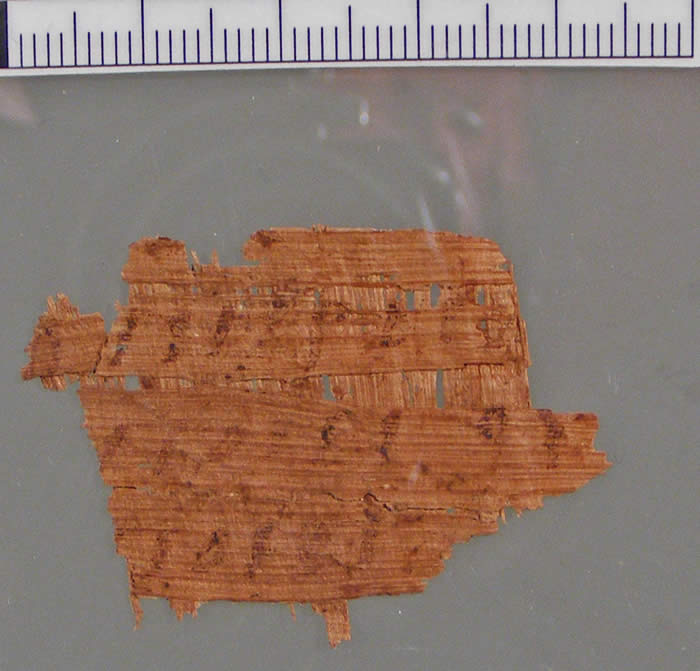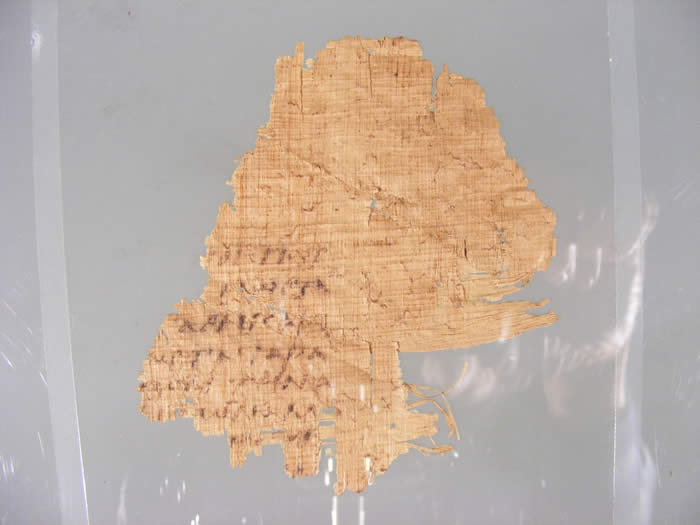History of Discovery and Research on PPennMuseum E16694.patr
Fragments
by Robert A. Kraft, UPenn
(first presented publicly at the Oxford Patristics Conference, 23 Aug
1995)
These pieces are part of a miscellaneous collecton of papyri and
related materials acquired by the University of Pennsylvania Museum
around 1911 (see the History of the
Collection). They were first flattened and photographed (black and
white) by myself in April 1967 with the following notes:
Greek Codex fragments; very large book
hand (Coptic traits?), in dark brown ink with letters slanted to the
right.
Subsequently a photo was sent to C. H. Roberts, who kindly returned
some notes on possible readings and the comment "I am by no means sure
that it is a Christian text" (dated 1 Apr 1968). As it turned out, his
readings of frg 2 proved less useful than my own.
That's pretty much where matters stood until 7 Feb 1973, when I
discovered another similar frg among other unmounted materials from the
same miscellaneous lot. Then, more than 20 years later it occurred to
me that a search of the TLG using a program that allows me to ignore
any blanks between words (on the IBYCUS System) would be appropriate,
and in June of 1994, I was able to identify the following two patristic
texts, but not all the frgs:
1a. E16694 frgs 2 + 5 (written
with the fibers) proved to be from John
Chrysostom In
Matthew [PG 57.304.38ff]
ὑπερβαίνει φιλοστοργίαν.
Τοῦτο γὰρ
01 κελεύω, φησὶ, δι’
ἕτερον μὲν οὐδὲν, ἵνα δὲ
02 ὑμᾶς ἀπαλλάξω περιττῶν
φροντί
03 δων. Κἂν γὰρ σήμερον μεριμνήσῃς
04 ὑπὲρ τῆς αὔριον, καὶ
πάλιν αὔριον
05 μεριμνήσεις. Τί οὖν τὸ
περιττόν;
06 Τί καταναγκάζεις τὴν ἡμέραν
πλέον
07 τῆς συγκεκληρωμένης αὐτῇ
08 ταλαιπωρίας καταδέχεσθαι,
καὶ
09 μετὰ τῶν οἰκείων πόνων
καὶ τὸ
τῆς ἐπιούσης προστιθεῖς αὐτῇ
φορτίον, καὶ ταῦτα οὐδὲν

[about 25 lines missing before the fragment on the other side]
1b. E16694 frgs 2 + 5 (written
against the fibers) the other side, next page [PG 57.305.1ff]
τηλικούτων,
ἡμεῖς ὑπὲρ μὲν τούτων
01 μεριμνῶμεν, ὑπὲρ δὲ τῶν ἐν τοῖς
02 οὐρανοῖς οὐκέτι, ἀλλ’
ἀντεστρέψαμεν
03 τὴν τάξιν, ἑκατέρωθεν μαχόμενοι
04 τοῖς λεγομένοις. Σκόπει γάρ· μὴ ζητεῖτε
05 τὰ παρόντα, φησὶ, καθόλου· ἡμεῖς
06 δὲ ταῦτα ζητοῦμεν διηνεκῶς.
07 Ζητεῖτε τὰ ἐπουράνια, φησίν·
08 ἡμεῖς δὲ οὐδὲ μικρὰν ὥραν ἐκεῖνα
ζητοῦμεν, ἀλλ’ ὅσην ὑπὲρ τῶν
βιωτικῶν ἐπιδεικνύμεθα τὴν μέριμναν,

2a. E16694 frgs 6 + 19 written
against the fibers preserve a lower margin from Marcellus/Athanasius De Incarnatione et Contra Arianos
[PG 26.1005 and 1008]; this identification was not discovered until the
next leaf of the same text (below, frgs 3, 4, 11 = 2c) had been identified. Since that
next attested page (below, frgs 3, 4, 11) preserves fragments also
written along the fibers from about 35 lines later in the same text,
the present page (written || then --) could have been the first part of
a bicolon (two joined pages from the middle of a quire, if the quire
began and ended ||, as seems to have been normal). The first side of the present page (the joined frg of which is
virtually illegible) should have ended about 35 lines above the second
side, perhaps with the words [PG 26.1005.30]:
ἐν τῷ Εὐαγγελίῳ λέγει· Τὸ γεγεννημένον
ἐκ τῆς σαρκὸς σάρξ ἐστι, καὶ τὸ
γεγεννημένον ἐκ τοῦ Πνεύματος πνεῦμά ἐστι.
01 Καὶ πάλιν· Τὸ Πνεῦμα ὅπου θέλει, πνεῖ,
02 καὶ τὴν φωνὴν αὐτοῦ ἀκούεις·
ἀλλ’
03 οὐκ οἶδας, πόθεν ἔρχεται, καὶ
ποῦ
04 ὑπάγει. Οὕτως ἐστὶ πᾶς
ὁ γεγεννη-
[the lower margin is expected here, with the
flip side beginning as below]

2b. E16694 frgs 6 + 19 written
along the fibers
μένος ἐκ τοῦ Πνεύματος. Ἐν δὲ τῇ ἀρχῇ τοῦ
Εὐαγγελίου Ἰωάννης λέγει· Ὅσοι δὲ ἔλαβον
αὐτὸν, ἔδωκεν αὐτοῖς ἐξουσίαν τέκνα Θεοῦ . . .
[missing lines]
. . . πολυτρόπως πάλαι ὁ Θεὸς λαλήσας
01 τοῖς πατράσιν ἐν τοῖς
προφήταις, ἐπ’ ἐσ-
02 χάτου τοῦ ἡμερῶν τούτων ἐ-
03 λάλησεν ἡμῖν ἐν Υἱῷ.
Καὶ ἀλλαχοῦ λέ-
04 γει, ὅτι ὁ Υἱὸς λαλεῖ· Εἰ δοκιμὴν, φησὶ,
[bottom margin]

2c. E16694 frgs 3 + 11 written
along the fibers preserves a right margin and lower margin (frg 11),
from the next page of Marcellus/Athanasius
De Incarnatione [PG 26.1008]; and frg 4 has parts of 3 lines from the
left margin of the same page.
This page would have contained about 35 lines, beginning with the words
ζητεῖτε τοῦ ἐν ἐμοὶ λαλοῦντος Χριστοῦ.
Ὁ δὲ Υἱὸς τὸ Πνεῦμα εἶπε τὸ λαλοῦν ἐν τοῖς . .
. [missing lines]
. . . Εἴ τις γάρ ἐστι ναὸς
01 τοῦ Πνεύματος, οὗτος ναός ἐστι τοῦ Υἱοῦ καὶ
02 τοῦ Πατρός· ὅπου γὰρ τὸ Πνεῦμα τοῦ Θεοῦ κα
03 τοικεῖ, ἐκεῖ ὁ Θεὸς κατοικεῖ. Καὶ,
Ὥσπερ
04 ὁ Πατὴρ ἐγείρει τοὺς νεκροὺς καὶ ζωο
05 ποιεῖ, οὕτως καὶ ὁ Υἱὸς
οὓς θέλει ζωο
06 ποιεῖ. Ὁμοίως δὲ καὶ
περὶ τοῦ Πνεύματος
07 λέγει, ὅτι Τὸ Πνεῦμά ἐστι τὸ ζωοποιοῦν,
08 ἡ σὰρξ οὐκ ὠφελεῖ οὐδέν. Πρὸς
δὲ
09 Κορινθίους γράφει Παῦλος·
Τὸ δὲ
10 Πνεῦμα ζωοποιεῖ. Ὁρᾷς, ὅτι ἅπερ
ἐστὶν
[lower margin]

2d. E16694 frg 3 written
against the fibers has a left margin, from the next page [PG 26.1009];
frg 4 has parts of 3 lines from the left margin, and frg 11 has the
last line and lower margin, but lines 4-9 (at least) must have had
significant variants from the TLG text. For frg 4v see below!
ἔργα τοῦ Πατρὸς, ταῦτα λέγει . . .
[about 24-25 lines missing from top of the
page to the next preserved material]
μερίς μου εἶ ἐν γῆ ζώντων. Ὁ δὲ Ἱερεμίας
λέγει, ὅτι Ὁ πλάσας τὰ πάντα,
01 αὐτὸς κληρονομία τοῦ
Ἰακὼβ, Κύριος
02 ὄνομα αὐτῷ. Τῶν οὖν
προφητῶν
03 τὸν Κύριον
κληρονομίαν
04 λεγόντων τῶν ἁγίων, ὁ
Παῦλος τὸ
05 ἅγιον Πνεῦμα
κληρονομίαν εἶναι εἶπεν·
06 Ἐν ᾧ, φησὶ, καὶ
πιστεύσαντες, ἐσφρα-
07 γίσθητε τῷ Πνεύματι
τῆς
08 ἐπαγγελίας τῷ ἁγίῳ,
ὅ ἐστιν ἀῤῥαβὼν τῆς κληρονομίας ἡμῶν· ὡς καὶ Μωσῆς τὸ
09 πρόσωπον ἐσφραγίσθη
τῷ ἁγίῳ
10 Πνεύματι, ὅτε ἔλαβε νόμον
παρὰ Θεοῦ,

frgs 4 and 11 appear to be part
of the same page as frg 3, but
4v indicates significant
variation in lines 4ff.


No identification has been made for frg 1 and a few more smaller
pieces.
3a. E16694 frg 1, written with
the fibers ("recto"), is an upper left corner, with margins preserved
-- not yet identified

3b. E16694 frg 1, written
against the fibers ("verso"), is an upper right corner, with margins --
not yet identified

Unfortunately, Colin Roberts had not seen fit to comment on the
possible date of the hand -- pending closer computer examination, the
frgs all seem to come from the same hand. My own relatively
unsystematic probes thus far suggest that the paleographical date range
is wide, from 4th to 7th (or even 8th) centuries. To say "6th to 7th" does not narrow things very much.
A physical description can be made with much more confidence. The Chrysostom piece probably represents
a page of about 33 lines, with an average of 25-30 letters per line.
There are probably some minor textual variations, such as the absence
of gar in two places.
The Marcellus (or is it Athanasius?) fragments are similarly
formatted, with a similar number of lines per page (33-36), and about
the same number of letters per line as the Chrysostom piece. Of course, textual
variants in the many missing lines could easily affect the respective
page sizes. My suspicion is that they were basically the same format,
perhaps the same codex. The usual "nomina sacra" seem to have been
abbreviated in the usual manner for this period. The two Marcellus pages may have been the
inner bicolon of a quire, or two consecutive pages at the break between
quires.
What is the remaining large unidentified fragment (#1)? Are we dealing
with a large codex or series of patristic codices, or possibly with a
more modest book of excerpts of some sort? Your help is invited. How
unusual is it to have such fragments on papyrus? Do we have other
evidence for these authors "traveling together," as it were? What is
this "Marcellus" text, and how
is it associated with Athanasius?
The University Museum collection also includes two items that were labelled "Original" roll #1 (L 55-232B) and roll #2 (L 55-232C) when I worked with them in 1967. They include large pieces with wide margins and little evidence of writing that appear to be similar to fragment #1 above, and thus might be related to the patristic materials. This requires further exploration
As for the technological aspects of working with such materials, the "unofficial" digitized images are being made available for wider
inspection until the official scans from the University Museum are
ready. My presentation to the Berlin Papyrological Congress, dealing
with some non-literary fragments at the University's Center for Judaic
Studies, illustrates how computer assisted maniputlation of the images
can aid in the research.
//end; updated and transferred to html 30ja2009 and 03fe2009//







